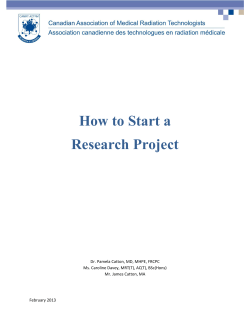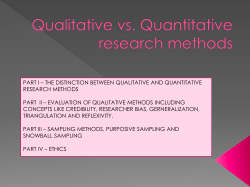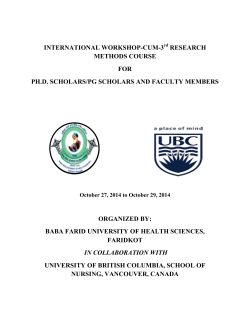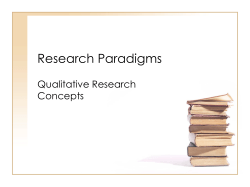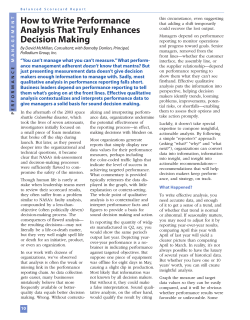
Qualitative Research Methods There’s more to it than meets the eye!
Qualitative Research Methods There’s more to it than meets the eye! Qualitative Methods 1. Get over the idea that research means counting. 2. The focus is on subjective experiences, or the meanings that people use. 3. Because meaning resides in language (people think with language), qualitative research largely involves studying text. 4. The best device for collecting and analyzing qualitative information is the human brain. Introduction Qualitative Methods 5. Qualitative research is local, concrete. 6. Observations and findings depend on understanding contexts and the meanings held by the people in those contexts and the meanings of the things in those contexts. 7. Observations are typically of interactions in smaller groups or selectively defined settings. 8. Exploration is very often the motive, but not always. Introduction Qualitative Methods 9. Qualitative research often provides idiographic (as opposed to nomothetic) causal explanations. 10. Qualitative research is typically inductive. 11. The research is reflexive—design is flexible and can change given the needs of the research. E.g., Theoretical Sampling 12. The researcher must be reflexive as well—the brain tool must be calibrated, understood, active, paid attention to, controlled Introduction Qualitative Methods 13. Qualitative research is very practical, logical, and critical of itself. Researchers constantly ask, “Am I accurately depicting the social world given the ways I am collecting and analyzing my data?” 14. Good qualitative research is often the most rigorous, difficult research. Introduction DEDUCTIVE & INDUCTIVE REASONING Elements of the Research Process Deductive thinking (Quantitative) THEORY HYPOTHESIS OBSERVATION CONFIRMATION Elements of the Research Process (Cont.) Inductive thinking (Qualitative) OBSERVATION PATTERNS HYPOTHESIS THEORY IDEAL QUANTITATIVE Research process is deductive. Measure objective facts. Focus on variables. Firewall between research process and researchers’ values. Cross-contextual. Many cases. QUALITATIVE Research process is inductive. Document social reality, meaning is constructed. Focus on in-depth meaning. Values are present & explicit (empathy). Contextual dependence. Few cases. IDEAL QUANTITATIVE QUALITATIVE Statistical analysis Thematic analysis Highly structured research process. Loosely structured research process. Particularistic, specific Holistic perspective Separation from data Intimacy with data Generalize to population Generalization to properties and contexts Qualitative Methods When should I use qualitative methods? •When variables cannot be quantified •When variables are best understood in their natural settings •When variables are studied over real time •When studying intimate details of roles, processes, and groups •When the paramount objective is “understanding” Qualitative Methods What skills do I need? • Must have requisite knowledge and skills about methodology, setting and nature of the issue. • Must be familiar with own biases, assumptions, expectations, and values. • Must be empathic, intelligent, energetic, and interested in listening • Must be open to embracing multiple realities. • Must be prepared to produce detailed, comprehensive, and sometimes lengthy reports. Source: (Kuh & Andreas, 1991) Qualitative Methods Before collecting data, you have to determine what you want to accomplish. Tight versus Loose Design Ask yourself: – – – – How much time do I have? What resources are available? What is the purpose of the study? In what am I really interested? More structure can prevent waste – – – Design If we already know about the context, it would be wasteful to go exploring If you have targeted topic, you can reduce data at the collection stage and cut down on analysis time Loose produces more data, more “surprise discoveries” can be made Qualitative Methods Choose your unit of analysis. • Individuals – Certain experiences – Experiences in particular settings – Identities such as student with disabilities, ex-con • Groups – – – – – Design Demographic groups Intervention groups Types of people such as ball players, secretaries Those in one setting versus another Organizations Qualitative Methods Qualitative research quickly exhausts resources and time. Limit the amount of data collected. It’s not the size that matters, it’s what you do with the data. • Be very clear about the research focus – Write down your foggy ideas and then get more specific. • Concentrate on most important issues and not others. – Start writing specific questions you want to answer. – Now get even more specific…reduce Design Sampling Plan Data Collection • Define sampling boundaries: – – – – Space Time Social position Context • Record nothing that is not in your sampling parameters Design Sampling: Qualitative versus Quantitative Quantitative Sampling Select Elements Representative of Target Population Generalize from sample to population Make claims about the population Test theories within population Qualitative Sampling Select Elements Representative of Research Focus Generate Detailed and Subjective Understanding Answer research questions Build theories Sampling • Make choices that narrow or delimit research focus and activities to a level that – A researcher’s brain can handle – Can be done in a reasonable amount of time – Is within a reasonable budget • Seek exposure to topic-related information • Focus only on information directly useful for the research – Samples should be small, not large • Sampling Sampling decisions are made throughout data collection Data Text is generally collected from or in the form of… – Field notes -- Newspaper or magazine stories – Interviews (recorded and transcribed) – Focus groups -- Web pages – Audio & video tapes (transcribed and described) – Copies of documents – Narrative descriptions – Diaries -- Photographs (described) ANALYSIS 1. Read Data, develop ideas and feelings 2. Code Data, tag items with same meaning using a unique code 3. Search and extract instances of codes 4. Identify patterns among codes (pattern coding) THEMES 5. Create figures, tables, or descriptions of patterns Analysis • Process of Qualitative Analysis: – Data Reduction – Data Display – Conclusion Drawing and Verification Analysis Coding Coding What is coding? • In qualitative analysis, coding is the process of identifying categories and meanings in text, creating and applying a name or code to each, and systematically marking similar strings of text with the same code name. • Coding permits systematic retrieval of categories and meanings during analysis. Codes help researchers identify patterns in data. Coding • One codes only relevant data (Not all text must be coded to complete the project) • Codes may be based on: Actions, Behaviors,Topics, Ideas, Concepts, Terms, Phrases, Keywords, and so forth • Coding is purposeful interpretation, with mindful reflection on the meanings of the persons, context, interactions, statements, assumptions, and so forth Coding An example of “old school” coding Source: http://onlineqda.hud.ac.uk/Intro_QDA/phpechopage_titleOnlineQDA-Examples_QDA.php Coding Sources of codes (typically both): 1.A priori codes—expected, looked for – – – – Previous research Previous theory Research question Your intuition of the data or setting 2.Grounded codes—discovered (suspend ideas about the subject and let the data determine codes) Coding • It helps if code names are meaningful. • When new relevant content is discovered, a new code is created. • Codes may evolve • A string of text may contain more than one code. Coding • Codes must be consistently applied • Keeping a list of codes helps to: – Identify the content of each code, and – Reveal the contents of the text. • Codes should be grouped in some form (e.g., related clusters) to advance analysis Coding http://www.qualitative-research.net/index.php/fqs/article/view/209/461 Displays Making sense of the data Displays • There are numerous legitimate ways to move from codes to final narrative, but core among them is systematic work and adherence to logic. • Systematic analysis is advanced when codes are put into “data displays” which reflect the researcher’s judgments about the data • Data displays link various codes and help to build themes Displays Thematic network of YouTube comments about Borat Source: http://journals.culture-communication.unimelb.edu.au/platform/yecrea_2011_kaprans.html Displays • Such arrangements help researchers: 1. “dimensionalize,” or recognize dimensions of similar thoughts or • E.g., thoughts about how to appear masculine: • Clothes Presence – Short hair – Plain shoes – Shirt with collar -- Confidence -- Taking up space 2. Connect codes in more sophisticated ways 3. Document patterns in “user-friendly” ways (never rely on memory) Displays • Relationships between codes become more apparent as codes are grouped • Themes should be explored – Why do some codes co-occur? – Why are some dimensions related to other codes while others are not? – Are some codes linked to particular emotions? • Exploration of themes is analysis. The discoveries should be written down. These eventually (with very heavy and serious editing) turn into your written text. Analysis • Process of Qualitative Analysis: – Data Reduction – Data Display – Conclusion Drawing and Verification Drawing Conclusions and Verification • As one creates and views displays, the salient components of meaning and activities become apparent. • Research may be: – Descriptive: Represents the data (meanings, observations) to readers in such a way that they will “understand” what the researcher “sees” in the data. – Causal: Links concepts in the data together to explain observed meanings or phenomena, and to write in such a way that readers will “understand” what the researcher “sees.” • This stage relies very heavily on logical evaluation and systematic description Drawing Conclusions and Verification • The researcher WRITES what he or she sees as logical descriptions of themes • The researcher always refers back to the data displays and raw data as descriptions or causal statements are made. – Systematic, organized, and good coding and notes will really pay off at this point, allowing efficient, accurate access to data • Conclusions are made through this process Drawing Conclusions and Verification • Articles and reports often include quotes. They are not the text “speaking for itself.” • Quotes are used for: – Evidence – Explanation – Illustration – Deepening understanding – Giving participants a voice – Enhancing readability Drawing Conclusions and Verification In the end, like good quantitative research, good qualitative research gives a portrayal of the human experience that is as accurate as possible, but which always has limitations. Qualitative Methods • • It is often difficult to plan qualitative research Group Discussion: – – Spend several minutes generating ideas for a qualitative research study. What are you going to study and why? Create a plan for: • Sampling – • • Data Collection Data Analysis – • Introduction How will you determine whether your sample is representative of a target group? How will you evaluate causality? How will you write about or present your findings?
© Copyright 2025




